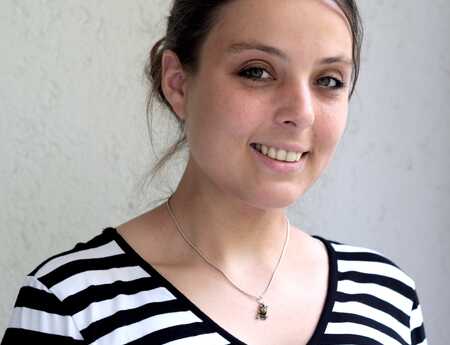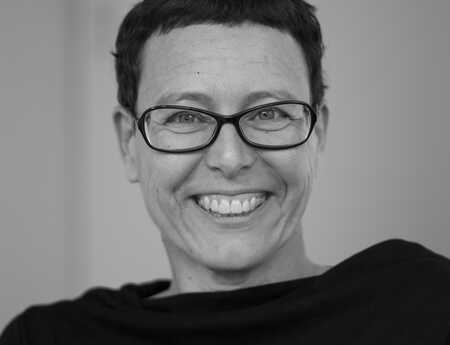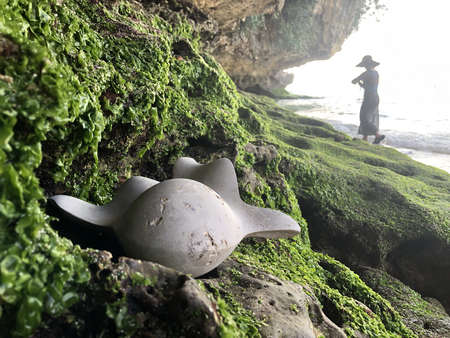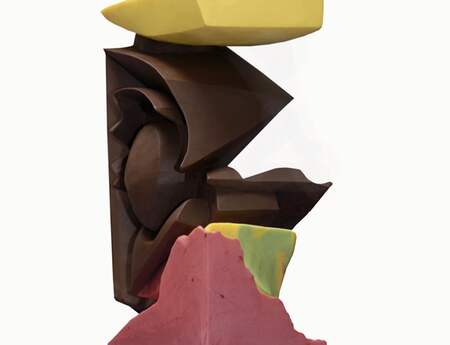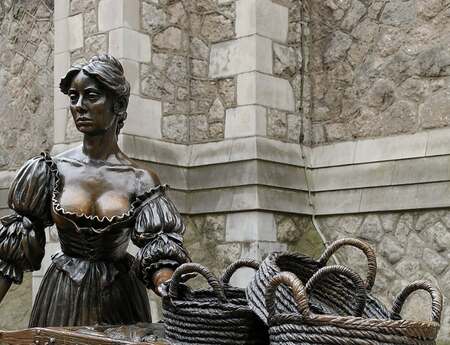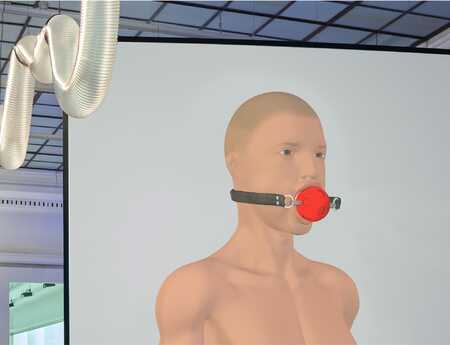Lessons on Weight and Lightness, or: What to Take Away from a Residency in Bali
Monika Majer is a fully trained stonemason and has been working as a freelance artist near Kirchheim unter Teck for more than 20 years. Her passion: stone in all of its facets. Monika, a member of Sculpture Network since 2017, experienced an exciting 2023: she won an international art prize, was awarded an artist residency in Bali, and started to create sculptures that gave her work a completely new direction. We talked to Monika all about these changes.
Monika, you recently came second in the ArtGemini Prize 2022 with your sculpture without further ado (take off). First of all, congratulations! The prize was awarded in Singapore in 2022, not exactly around the corner. What made you decide to enter your sculpture in this competition?
I spotted the call for entries for the art prize on social media and saw that it was linked to an artist residency in Bali. That really tempted me because I always wanted to spend more time travelling the world. Stone is to be found everywhere, and that is exactly what interests me: what kind of stone exists elsewhere, how do people deal with it, and what significance does stone have there? When I applied, I didn't realise that the award-winning exhibition would take place in Singapore. Then, at the beginning of January, I received the news: you have been selected for the exhibition, please send the submitted work to Singapore ... And then I thought: Oops, to Singapore?
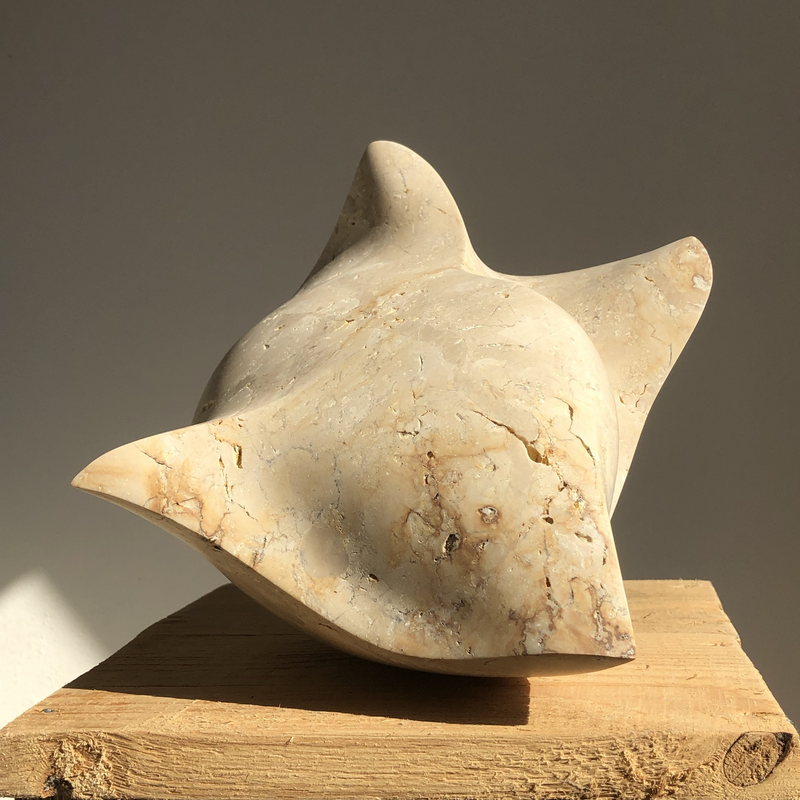
No easy endeavour when it comes to a sculpture made of stone. So you actually sent your work halfway around the globe?
Yes, indeed. I had to deal with a whole new set of questions: How do you ship a sculpture over to Asia? What do you have to take into account? Who is doing it for you? It was very challenging, both in terms of time and effort and in terms of money. But fortunately, I have a great network, colleagues that provided me with initial tips, and incidentally, my daughter deals with shipping issues in her job. And there is also actually a consulting agency in Berlin for artists who exhibit abroad or do artist residencies, Touring Artists . That's who I got in touch with, also about all the legal issues, and later again when I went to Bali. I found that very supportive. It all worked out really well, and in the end, I was very pleased that the sculpture was actually selected. It was great to be rewarded with the prize, in a way, for all the effort.
Were you personally present at the award ceremony in Singapore?
Sadly not, but if I had known how expensive the shipping would be, I would have booked a flight for myself and taken the sculpture with me in my hand luggage. Next time, I'll definitely know better.
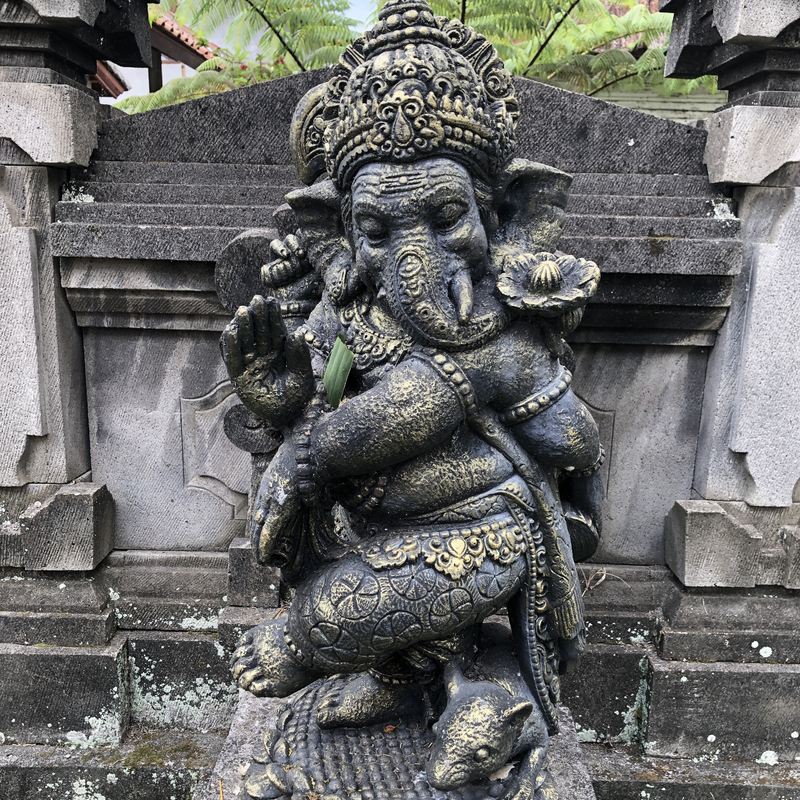
Luckily, you were allowed to pack your bags a little later anyway. The first and second prize winners were additionally awarded a residency in Bali in October. How did you experience your time in Bali?
Extremely intense. I've never before visited a country with a different culture, that is, a culture that is not predominantly Western. Bali is such a country, characterised by so many incredible contradictions. Moreover, all the sounds and smells are so very different from here. The entire feeling of energy, how people move and interact with each other, is entirely different from the way it is here. For me, it was really an intensive experience to deal with this completely other form of energy, this whole culture.
What was the overall idea or rather the objective of the residency?
This artist residency was kind of a novelty. It was made possible by one of the jurors of the ArtGemini Prize, Benny Oentoro . His intention was to enable the first two award winners the opportunity to gain insight into a different culture and to practice their art in Bali. Initially, the theoretical idea was that we would spend four days travelling around Bali, making contacts with local artists so as to learn a little about the culture. We would then have nine days to work on a piece of art, with the aim of having an exhibition at the end. Such was the plan. But on day one, Benny said: "I don't think my plan is going to work. It's too tight. We could do it like this, but it wouldn't have any real substance. I think we need more time to go around and watch and to arrange encounters so that you can find your way here at all. Do whatever you feel like doing, and then we'll organise a 'proper exhibition' next year." And so we changed the conceptual approach of this residency: we scaled down the programme a little, added additional encounters, and the like.
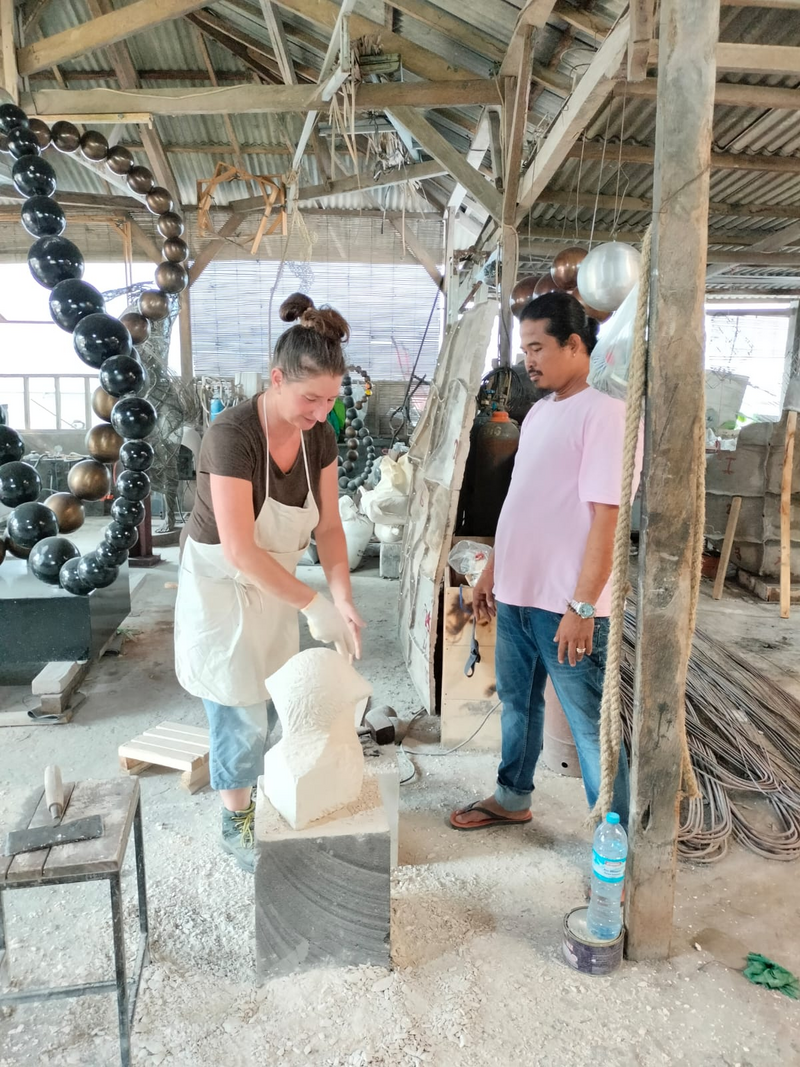
How exactly did actually working there turn out for you?
It was a bit funny: at the beginning, Benny said he had found a nice hotel for us, the first prize winner, the Korean painter Jione Choi, and me. We could work on our pieces there. That's when I replied: "You know, if I start working with stone in the hotel room, that will be the last time you ever booked a room there." This led him to make a wonderful contact with a Balinese sculptor with a large studio who is also working internationally: I Ketut Putrayasa . He was an enormous source of support. On the one hand, because he devoted so much time to helping me and shared so many insights into Balinese culture and art, and because he is simply a very, very knowledgeable person. On the other hand, he provided me with a place where I could work and also with stones and tools. The pressure of the thought "we have to work towards an upcoming exhibition" was gone, instead, I was able to experiment, explore, and simply take things easy: What's it like here? How does it feel to work here?
I'm sure you have faced one or two challenges along the way. I seem to remember an Instagram post with a sculpture floating away...
I brought some sculptures with me from home, originally intended for an encounter between the limestone from Germany and the lava stone from Bali. But as I finally didn't do any work with lava stone in Bali, I had the idea of at least photographing the sculptures there. My intention was to find out: What kind of resonance is there between the German limestone and that which is in Bali, the local rock? So Benny and I planned a trip to the beach. We were both completely fascinated by the effect the sculptures had there. The sand on the beach had the exact same colour as the limestone from home. And then you come along with this sculpture made of limestone, and limestone is something that came out of the sea, and you bring it back to the sea. We were so excited about it that we didn't pay any attention. Suddenly a big wave came, and, poof, it took the sculpture away! Actually, a leg was broken off. For me, that's nothing to worry about. I start asking myself: What do I do with it now? What deeper meaning could it have? On the northern side of Bali, where you find the black beaches, I later collected some very fine black sand and asked Ketut if he could use the sand to make a mould from the broken piece and reattach the piece cast from the dark sand. That's what he's going to do now.
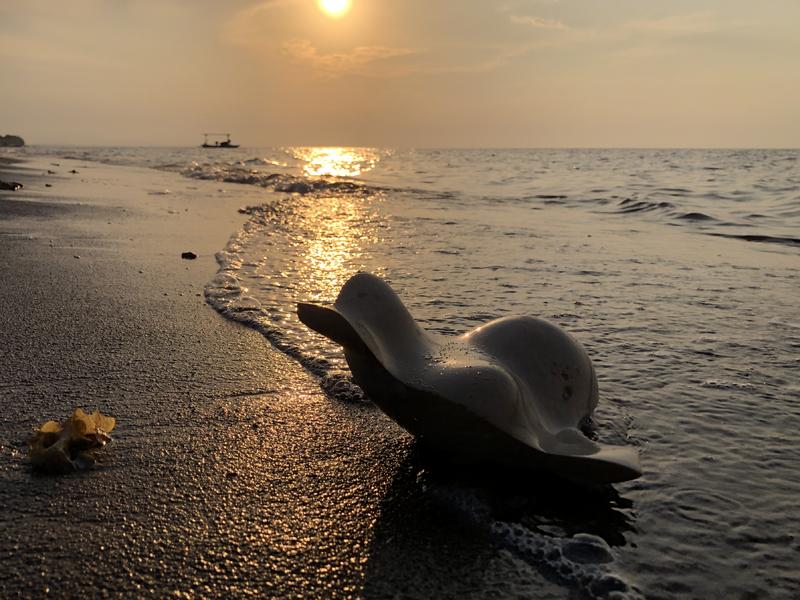
Well, that shows very nicely how important the subject of materials is for you as a sculptor. At home near Kirchheim unter Teck, you mainly work with local materials, such as limestone. How did you feel working with new types of stone in Bali?
Here I work with limestone, which is naturally available in the region, so I wanted to work in Bali with stone, which is traditionally available there. My basic idea was to combine the two. I took sculptures made from Franconian Jurassic rock with me to Bali and actually wanted to combine them with works made from Balinese lava stone. I am fascinated by these two different stories of genesis: the limestone, which is formed by sedimentary material in the sea, and the lava stone, which originates from this fiery energy from within the earth. The lava stone comes from the inside, so to speak, and the limestone forms on the outside. In theory, that was actually what would have interested me. In practice, however, it didn't work out that way. I think I would have needed a lot more time to come to terms with the stone itself. In these two weeks, I have only managed to get by somehow. It is hot, with a humidity of 80 percent. I literally don't understand a word of the language. Everything is so different. I had to find my way first: how do the local stonemasons work, what tools do they use, how do they go about it technically? Ketut gave me a Balinese lava stone, along with a harder limestone and a very soft limestone from the neighbouring island of Java. In the end, I made up my mind: I would just work with the softest and easiest to work with.
How do the working methods and techniques for stone processing used in Bali differ from those you know?
In Germany, I have my compressor and my pneumatic tool. In Bali, people work by hand, but the tools they use are very similar to ours. As you know, I was trained as a stonemason over 30 years ago, in the traditional way back then: without compressed air, in the quarry, all by hand. I found very similar tools to the ones we work with here in Bali. I mainly worked with an axe while there. A very similar axe is also used here in Germany for traditional stone carving. But the technique is different. The stone axe used here is mainly for working on surfaces and is held with both hands. In Bali, it is mainly used for rougher work and is held with one hand only. I then combined the two techniques, so I used it first for the rough work and then took it for the very fine finishing stage, which the Balinese don't do at all. So I partly used it in a completely different way, but I also used it the way they do.
![Caption: Patuk (Balinese stone axe) and the early stages of a sculpture made of Paras Jogja (limestone from Java). © Monika Majer]](/image/2023/12/21/bild5.jpg%28mediaclass-body-media-large.f3e77e90eca3bc50a4088e9be6316e2311c9a25b%29.png)
What a fascinating fact that the basic features of stone processing are so similar.
Yes, that's really fascinating: I'm learning such a traditional craft, and it's just as much a traditional craft on the other side of the world, even though we are from different cultures. It reminded me of the very roots of my own relationship with stone and the reason why I once started working with it. You only have to look at the Minster in Ulm – you will find very similar types of building elements on the other side of the world. There, it's just a temple. But it, too, is carved out of stone. There too are ornaments, there too are figurative depictions and images of saints or else gods and demons. This desire to create something and to seek a connection to something larger and more mighty than our small human existence is something fundamental. You can be at any given place, and you will find similar aspects of what make us human.
In what way do you think your Bali sculpture differs from what you usually do?
The sculptures I took from here to Bali had the theme: something with lightness. They had to be smaller works that were light because of the issue of freight and weight. And as I find it quite challenging to travel halfway around the world, and venture into a different culture, and have confidence, inner lightness was also an issue. The sculpture that was completed in Bali is entirely different. It does have these clear lines – something quite characteristic of me – but this is not true for the reclining. Most of my sculptures are more horizontally balanced, and this one is more of a vertical form. It also has something figurative about it, almost like a bust.
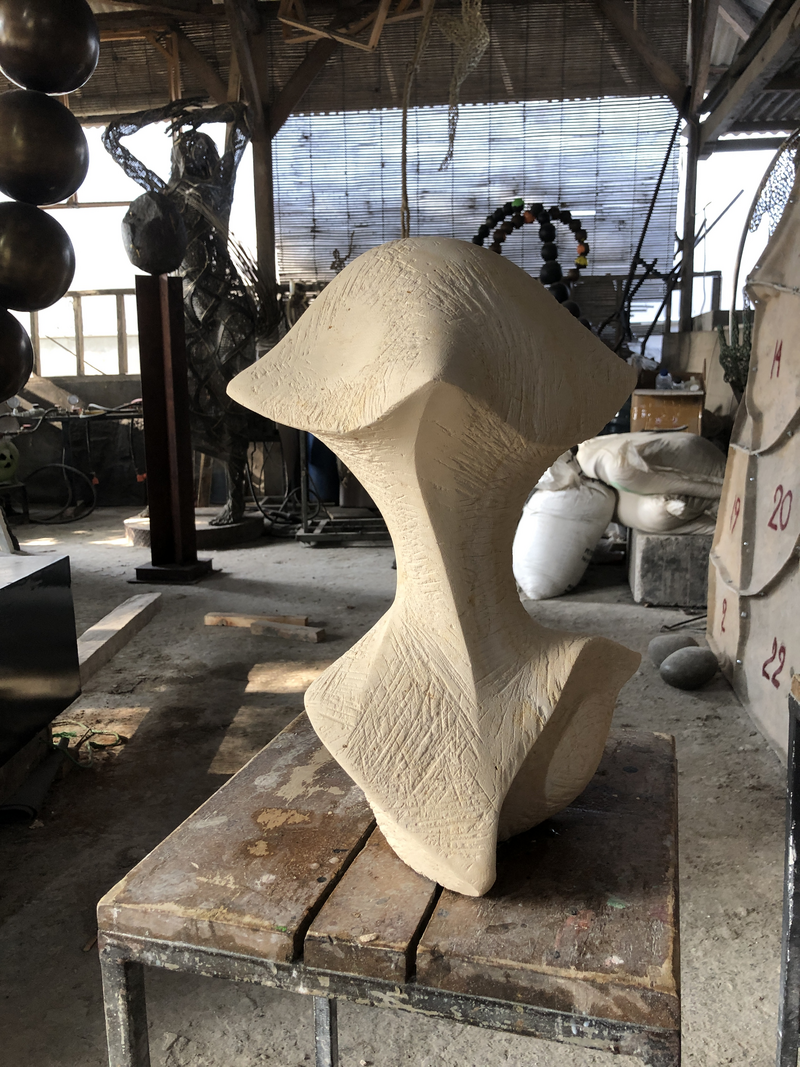
And it has a lot more structure than your other sculptures. There, the surfaces are usually smooth.
Exactly, this strong structure is achieved by using the axe. Here, you can clearly see how the structure has become supportive of the form. Something I know from my earlier work. I returned to that a bit, also owing to the tool. In addition, I also had many conversations with Ketut. We exchanged views on the subject of surface, it was about: How do you achieve a balance? If everything is structured, then it's too much, and you no longer know where to look. So how can it work out that one part, as I usually do, is polished and very fine and another part remains rough? It was an attempt to set individual accents.
Looking back on your working stay, what will you transfer into your day-to-day work here?
I would like to pursue this way of working a little further. I also take Ketut's teachings with me, teachings on certain topics relating to art, symbolism, geometry, and the like. Although I did learn this during my training and studies in design and worked very consciously according to these principles for a while, I put them aside at some point and do it intuitively now. Right now, I would like to make myself more aware of certain decisions that I intuitively make, also in terms of form. Take a closer look: Where does that point me to? Or where does it connect me in terms of the underlying symbolism? I do believe that we all draw on a kind of collective knowledge. If something appears over and over again throughout the millennia, be it as a form or a symbol, then I strongly believe it must be embodied somewhere.
Thank you very much, Monika, for sharing these fascinating insights with us. One final question: What is it that Sculpture Network offers you personally as an artist?
As an artist, it mainly gives me the opportunity to connect with other sculptors. I think it's something special that it's a Sculpture Network. It's something different to talk to a painter than to a sculptor; it simply adds another level – three-dimensional, in other words.
More Info: Monika Majer

